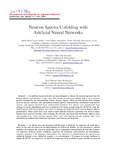
Please use this identifier to cite or link to this item:
http://ricaxcan.uaz.edu.mx/jspui/handle/20.500.11845/787Full metadata record
| DC Field | Value | Language |
|---|---|---|
| dc.contributor | 6207 | es_ES |
| dc.contributor.other | https://orcid.org/0000-0002-7081-9084 | es_ES |
| dc.coverage.spatial | Global | es_ES |
| dc.creator | Vega Carrillo, Héctor René | - |
| dc.creator | Hernández Dávila, Víctor Martín | - |
| dc.creator | Manzanares Acuña, Eduardo | - |
| dc.creator | Mercado Sánchez, Gema Alejandrina | - |
| dc.creator | Arteaga Arteaga, Tarcicio | - |
| dc.creator | Ortíz Rodríguez, José Manuel | - |
| dc.date.accessioned | 2019-03-15T16:31:38Z | - |
| dc.date.available | 2019-03-15T16:31:38Z | - |
| dc.date.issued | 2005-03 | - |
| dc.identifier | info:eu-repo/semantics/publishedVersion | es_ES |
| dc.identifier.uri | http://localhost/xmlui/handle/20.500.11845/787 | - |
| dc.identifier.uri | https://doi.org/10.48779/j6mp-8w60 | es_ES |
| dc.description | An artificial neural network has been designed to obtain the neutron spectra from the Bonner spheres spectrometer's count rates. The neural network was trained using a set of neutron spectra compiled by the International Atomic Energy Agency. These include spectra from isotopic neutron sources, reference and operational neutron spectra obtained from accelerators and nuclear reactors, and spectra obtained from mathematical functions. The spectra were transformed from lethargy to energy distribution and were re-binned to 31 energy groups using the MCNP 4C code. Rebinned spectra and UTA4 matrix were used to calculate the expected count rates in Bonner spheres spectrometer. These count rates were used as input and the respective spectrum was used as output during neural network training. After training, the network was tested with the Bonner spheres count rates produced by twelve neutron spectra, three were used during network training, three were obtained from mathematical functions and three were from actual situations. | es_ES |
| dc.description.abstract | Se diseñó una red neuronal artificial para reconstruir los espectros de neutrones a partir de las tasas de conteo de un espectrómetro de Esferas de Bonner. La red neuronal se entrenó mediante un conjunto de espectros publicados por el Organismo Internacional de Energía Atómica. Los espectros incluyen fuentes isotópicas, espectros de referencia, operacionales, de aceleradores, reactores nucleares y de funciones matemáticas. Los espectros se transformaron de espectros por unidad de letargia a por unidad de energía y se estructuraron a 31 grupos de energía mediante el código MCNP 4C. Los espectros y la matriz de respuesta UTA4 se utilizaron para calcular las tasas de conteo que cada espectro produce en un espectrómetro de Esferas de Bonner. Las tasas de conteo y los espectros se utilizaron para entrenar la red neuronal artificial. Después del entrenamiento la red se probó con doce espectros, tres se obtuvieron de los usados en el entrenamiento, tres se obtuvieron de funciones matemáticas y otros tres de espectros reales y no usados durante el entrenamiento. | es_ES |
| dc.language.iso | spa | es_ES |
| dc.publisher | Universidad Autónoma de Zacatecas | es_ES |
| dc.relation.uri | generalPublic | es_ES |
| dc.rights | Atribución-NoComercial-CompartirIgual 3.0 Estados Unidos de América | * |
| dc.rights.uri | http://creativecommons.org/licenses/by-nc-sa/3.0/us/ | * |
| dc.source | Encuentro de Investigación en Ingeniería Eléctrica Zacatecas, Zac, Marzo 17 —18, 2005 | es_ES |
| dc.subject.classification | CIENCIAS FISICO MATEMATICAS Y CIENCIAS DE LA TIERRA [1] | es_ES |
| dc.subject.other | Artificial Neural Network | es_ES |
| dc.subject.other | Unfolding | es_ES |
| dc.subject.other | Neutron spectrum | es_ES |
| dc.subject.other | Monte Carlo | es_ES |
| dc.title | Neutron Spectra Unfolding with Artificial Neural Networks | es_ES |
| dc.type | info:eu-repo/semantics/conferenceObject | es_ES |
| Appears in Collections: | *Documentos Académicos*-- UA Ciencias Nucleares | |
Files in This Item:
| File | Description | Size | Format | |
|---|---|---|---|---|
| Neutron_Spectra_Unfolding_with_Artificial_Neural_N2.pdf | 218,99 kB | Adobe PDF |  View/Open |
This item is licensed under a Creative Commons License
